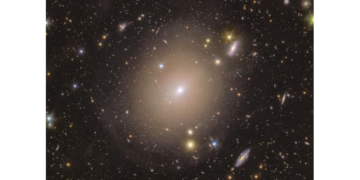The universe is filled with hidden wonders, waiting for advanced technology to uncover them. One such discovery has recently stunned the scientific community: the European Space Agency’s Euclid telescope has captured a rare Einstein ring around the galaxy NGC 6505.
The Euclid Telescope: A Mission to Explore the Dark Universe
The Euclid space telescope, launched on July 1, 2023, was designed to study the universe’s invisible components—dark matter and dark energy. Over the next six years, Euclid will create an extensive 3D map of billions of galaxies, helping astronomers better understand the expansion of the universe and the large-scale structure of cosmic matter. Before it could begin its full mission, however, Euclid underwent a testing phase to verify the precision of its instruments.
Euclid operates in a halo orbit around the second Lagrange point (L2), a stable position about 1.5 million kilometers from Earth. This unique location allows Euclid to observe the sky without interference from Earth’s atmosphere, providing an unmatched view of distant cosmic structures. Using advanced infrared and optical imaging, the telescope captures unprecedented details of galaxies billions of light-years away.
A Surprise During Initial Testing
During this calibration phase in September 2023, Euclid unexpectedly detected something extraordinary: a perfect Einstein ring surrounding the galaxy NGC 6505, located 590 million light-years from Earth. Though this galaxy has been studied for over a century, this striking gravitational lens had gone unnoticed—until now.
The Einstein Ring: A Window into the Universe
An Einstein ring is a stunning visual consequence of gravitational lensing, a phenomenon predicted by Albert Einstein’s General Theory of Relativity. When a massive foreground object—such as a galaxy—bends and distorts the light of a much more distant background galaxy, the light forms a circular structure around the foreground object, creating an Einstein ring.
How This Einstein Ring Was Formed
- The foreground galaxy, NGC 6505, acted as a gravitational lens.
- A much more distant galaxy, located 4.42 billion light-years away, was perfectly aligned behind it.
- As light from the distant galaxy traveled toward Earth, NGC 6505’s gravity warped and magnified the light, forming a bright circular shape.
This phenomenon provides scientists with an invaluable natural telescope, allowing them to study farther and fainter galaxies with incredible detail.
Why This Discovery Is So Important
1. A Perfect Laboratory for Dark Matter Studies
Dark matter remains one of the biggest mysteries in physics. While it cannot be observed directly, scientists infer its presence through its gravitational effects. Gravitational lensing—like this Einstein ring—offers a powerful method to map the distribution of dark matter in and around galaxies. Studying how mass bends light in such a precise and symmetrical way allows researchers to determine the amount and location of dark matter within NGC 6505.
2. Confirming Einstein’s Theories on Cosmic Scales
Einstein’s General Theory of Relativity describes how massive objects warp space-time, and this Einstein ring serves as a near-perfect real-world demonstration of these principles. The discovery adds to a growing body of evidence confirming Einstein’s predictions and helps refine our understanding of gravity on cosmic scales. By comparing observed data with theoretical models, physicists can explore any potential deviations from Einstein’s theory, which might hint at new physics beyond our current framework.
3. Providing Insights into Galaxy Evolution
The study of strong gravitational lenses allows astronomers to examine the physical properties of galaxies billions of light-years away. By analyzing how their light is bent and magnified, scientists can uncover information about their mass, shape, and composition—data that is otherwise impossible to obtain with conventional telescopes. This Einstein ring provides an opportunity to examine how galaxies grow and change over billions of years.
How Euclid’s Capabilities Shine in This Discovery
Precision Imaging with Advanced Instruments
Euclid is specifically designed to capture high-resolution images of distant galaxies. Unlike ground-based telescopes, which suffer from atmospheric distortions, Euclid’s location in space allows it to observe the cosmos with incredible clarity. This Einstein ring’s pristine structure is a testament to Euclid’s superior imaging capabilities.
The Promise of More Discoveries
Scientists predict that Euclid will discover over 100,000 strong gravitational lenses, a hundredfold increase from the fewer than 1,000 currently known. This will create one of the largest datasets for studying dark matter and galaxy formation, revolutionizing our understanding of the universe.
Future Implications: What’s Next for Euclid?
Expanding the Cosmic Census
Euclid is expected to complete its first major survey by 2025, providing data that will reshape modern cosmology. With every new observation, the telescope brings us closer to unraveling the true nature of dark energy—the mysterious force driving the universe’s accelerated expansion.
Refining Cosmological Models
The information gathered from gravitational lensing events like this Einstein ring will help refine models of the universe’s evolution. Astronomers will use these findings to test competing theories about dark matter interactions and the geometry of space-time.
Conclusion: A New Era of Discovery
Euclid’s stunning Einstein ring discovery is just the beginning. This mission will push the boundaries of our knowledge of gravity, dark matter, and the large-scale structure of the universe. With its unparalleled ability to map billions of galaxies, Euclid is set to transform our understanding of the cosmos and answer some of the most fundamental questions in astrophysics.



















